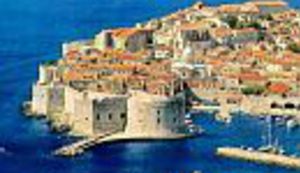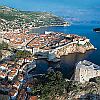
Destination Dubrovnik
 DUBROVNIK, a town, port and tourist centre of the southern Croatian coast; population 49,278. It lies at the foot of the limestone Srd Mount (412 m), in a valley enclosed to the south-west by the Lapad plateau and a smaller reef with the oldest part of Dubrovnik. The ancient town core was connected with the suburban zone on the other side of the valley by levelling and filling up of a marshy valley between the Gruz Bay in the north and Stari Porto (Old Port) in the south, as well as by the construction of the Placa (Stradun). Stradun thus became the centre of the town and its main street, connecting two opposite town gates: the Ploce Gate in the east and the Pile Gate in the west. Upon the construction of the port in the Gruz Bay, Gruz was gradually annexed to Dubrovnik and became an integral part of the town. Later on, Dubrovnik extended also to the Lapad peninsula, to lower parts of the Srd slopes and outside the town ramparts toward Zupa. The climate of Dubrovnik is characterized by warm and dry summers and mild winters. The average air temperature in the coldest month (February) is 4.6 °C and in the warmest month (August) 26.2 °C. The cold half of the year accounts for 68 % of the total annual rainfall; the spring accounts for 29, the summer for 14, the autumn for 26 and the winter for 37 rainy days out of the total number of 105 rainy days. Snow occurs extremely rarely; with 2,554 hours of sunshine a year, Dubrovnik ranks among the sunniest towns of southern Europe. In July it has 12.4 hours of sunshine a day, like Alexandria in Egypt. The vegetation is subtropical and extremely luxuriant (olives, almonds, citrus fruit, rosemary, laurel, holm oak, pine, stone pine, cypress). Southeast of the old part of the town is a tourist zone called Ploce (hotels and beaches), west of it is Lapad (sports facilities, hotels, beaches, walking trails), while northwest of it is the Gruz port and Gruz. Economy is based on tourism and seafaring. The town has a number of cultural and educational institutions: the Nautical College, the Tourist College, the University Centre for Postgraduate Studies of the University of Zagreb, the Institute of History of the Croatian Academy of Arts and Sciences, the Dubrovnik Summer Festival and other.
DUBROVNIK, a town, port and tourist centre of the southern Croatian coast; population 49,278. It lies at the foot of the limestone Srd Mount (412 m), in a valley enclosed to the south-west by the Lapad plateau and a smaller reef with the oldest part of Dubrovnik. The ancient town core was connected with the suburban zone on the other side of the valley by levelling and filling up of a marshy valley between the Gruz Bay in the north and Stari Porto (Old Port) in the south, as well as by the construction of the Placa (Stradun). Stradun thus became the centre of the town and its main street, connecting two opposite town gates: the Ploce Gate in the east and the Pile Gate in the west. Upon the construction of the port in the Gruz Bay, Gruz was gradually annexed to Dubrovnik and became an integral part of the town. Later on, Dubrovnik extended also to the Lapad peninsula, to lower parts of the Srd slopes and outside the town ramparts toward Zupa. The climate of Dubrovnik is characterized by warm and dry summers and mild winters. The average air temperature in the coldest month (February) is 4.6 °C and in the warmest month (August) 26.2 °C. The cold half of the year accounts for 68 % of the total annual rainfall; the spring accounts for 29, the summer for 14, the autumn for 26 and the winter for 37 rainy days out of the total number of 105 rainy days. Snow occurs extremely rarely; with 2,554 hours of sunshine a year, Dubrovnik ranks among the sunniest towns of southern Europe. In July it has 12.4 hours of sunshine a day, like Alexandria in Egypt. The vegetation is subtropical and extremely luxuriant (olives, almonds, citrus fruit, rosemary, laurel, holm oak, pine, stone pine, cypress). Southeast of the old part of the town is a tourist zone called Ploce (hotels and beaches), west of it is Lapad (sports facilities, hotels, beaches, walking trails), while northwest of it is the Gruz port and Gruz. Economy is based on tourism and seafaring. The town has a number of cultural and educational institutions: the Nautical College, the Tourist College, the University Centre for Postgraduate Studies of the University of Zagreb, the Institute of History of the Croatian Academy of Arts and Sciences, the Dubrovnik Summer Festival and other.
 DUBROVNIK, Hafenstadt und Fremdenverkehrszentrum des südkroatischen Küstenlandes; 49278 Einw. Am Fuße des Kalkberges SrD (Sergiusberg, 412 m) in einem Tal gelegen, das nach Südwesten hin mit der Anhöhe Lapad und einer kleinen Insel, die den ältesten Stadtteil Dubrovniks trägt, abschließt. Durch Aufschüttung des sumpfigen Tals zwischen der Bucht von GruZ im Norden und dem Alten Port im Süden und die Entstehung der Placa (Stradun) wurde der alte Stadtkern mit der auf der anderen Talseite liegenden Vorstadt verbunden. Somit wurde Stradun zur Haupt- und Flanierstraße der Stadt; ihre beiden Endpunkte sind die Stadttore PloCe im Osten und Pile im Westen. Nach dem Bau des Hafens von GruZ verbindet sich dieses Gebiet allmählich mit dem alten Stadtkern. Später breitet sich Dubrovnik auch auf die Halbinsel Lapad, die Sockelzone des Sergiusberges sowie außerhalb der Stadtmauern in Richtung Zupa aus. Das Klima prägen warme und trockene Sommer und milde Winter. Die Durchschnittstemperatur des kältesten Monats (Februar) beträgt 4,6 °C, die des wärmsten (August) 26,2 °C. Von der Gesamtniederschlagsmenge entfallen 68% auf die Winterhälfte; von 105 Regentagen entfallen 29 auf den Frühling, 14 auf den Sommer, 26 auf den Herbst und 37 auf den Winter. Schnee fällt äußerst selten; Dubrov-nik hat 2554 Sonnenstunden im Jahr und nimmt unter den südeuropäischen Städten eine führende Stellung ein. Im Juli gibt es täglich 12,4 Sonnenstunden (wie in Alexandria). Üppige und subtropische Vegetation (Oliven, Mandeln, Zitrusfrüchte, Rosmarin, Lorbeer, Steineichen, Kiefern, Pinien, Zypressen). Im Südosten des alten Stadtkerns liegt das Touristengebiet PloCe (Hotels und Strände), im Westen Lapad (Sportplätze, Hotels, Strände, Promenaden), im Nordwesten GruZ mit dem gleichnamigen Hafen. In der Stadt wirken wichtige Kulturinstitutionen: Fachhochschulen für Seefahrt und Tourismus, ein Universitätszentrum für Postdiplomstudium der Universität Zagreb, das Historische Institut der Kroatischen Akademie der Wissenschaften und Künste (HAZU), die Dubrovniker Sommerfestspiele u.a.
DUBROVNIK, Hafenstadt und Fremdenverkehrszentrum des südkroatischen Küstenlandes; 49278 Einw. Am Fuße des Kalkberges SrD (Sergiusberg, 412 m) in einem Tal gelegen, das nach Südwesten hin mit der Anhöhe Lapad und einer kleinen Insel, die den ältesten Stadtteil Dubrovniks trägt, abschließt. Durch Aufschüttung des sumpfigen Tals zwischen der Bucht von GruZ im Norden und dem Alten Port im Süden und die Entstehung der Placa (Stradun) wurde der alte Stadtkern mit der auf der anderen Talseite liegenden Vorstadt verbunden. Somit wurde Stradun zur Haupt- und Flanierstraße der Stadt; ihre beiden Endpunkte sind die Stadttore PloCe im Osten und Pile im Westen. Nach dem Bau des Hafens von GruZ verbindet sich dieses Gebiet allmählich mit dem alten Stadtkern. Später breitet sich Dubrovnik auch auf die Halbinsel Lapad, die Sockelzone des Sergiusberges sowie außerhalb der Stadtmauern in Richtung Zupa aus. Das Klima prägen warme und trockene Sommer und milde Winter. Die Durchschnittstemperatur des kältesten Monats (Februar) beträgt 4,6 °C, die des wärmsten (August) 26,2 °C. Von der Gesamtniederschlagsmenge entfallen 68% auf die Winterhälfte; von 105 Regentagen entfallen 29 auf den Frühling, 14 auf den Sommer, 26 auf den Herbst und 37 auf den Winter. Schnee fällt äußerst selten; Dubrov-nik hat 2554 Sonnenstunden im Jahr und nimmt unter den südeuropäischen Städten eine führende Stellung ein. Im Juli gibt es täglich 12,4 Sonnenstunden (wie in Alexandria). Üppige und subtropische Vegetation (Oliven, Mandeln, Zitrusfrüchte, Rosmarin, Lorbeer, Steineichen, Kiefern, Pinien, Zypressen). Im Südosten des alten Stadtkerns liegt das Touristengebiet PloCe (Hotels und Strände), im Westen Lapad (Sportplätze, Hotels, Strände, Promenaden), im Nordwesten GruZ mit dem gleichnamigen Hafen. In der Stadt wirken wichtige Kulturinstitutionen: Fachhochschulen für Seefahrt und Tourismus, ein Universitätszentrum für Postdiplomstudium der Universität Zagreb, das Historische Institut der Kroatischen Akademie der Wissenschaften und Künste (HAZU), die Dubrovniker Sommerfestspiele u.a.
 DUBROVNIK, grad, luka i turističko središte južnoga
DUBROVNIK, grad, luka i turističko središte južnoga  hrvatskoga primorja; 49 278 stan. Leži na podnožju vapnenačkoga Srđa (412 m), u dolini koju prema jugozapadu zatvara uzvisina Lapada i manji greben s najstarijim dijelom Dubrovnika. Nasipanjem močvarne doline između Gruškoga zaljeva na sjeveru i Staroga Porta na jugu i izgradnjom Place (Straduna) stara gradska jezgra spojena je s predgrađem na drugoj strani doline. Na taj je način Stradun postao središte grada i njegova glavna ulica, spajajući suprotna gradska vrata: Ploče na istoku i Pile na zapadu. Nakon izgradnje luke u Gruškom zaljevu, Gruž postupno s Dubrovnikom postaje jedinstveno naselje. Poslije se Dubrovnik proširio i na Lapadski poluotok, na niže dijelove padina Srđa i izvan gradskih zidina prema Župi. Klimu Dubrovnika karakteriziraju topla i suha ljeta i blage zime. Prosječna je temperatura najhladnijeg mjeseca (veljače) 4,6 °C, a najtoplijeg (kolovoza) 26,2 °C. Od ukupne godišnje količine oborina na hladnu polovicu godine otpada 68%, a od 105 kišnih dana otpada na proljeće 29, ljeto 14, jesen 26 i na zimu 37. Snijeg pada vrlo rijetko; 2554 sunčana sata godišnje, po čemu je Dubrovnik među prvim gradovima u južnoj Europi. U srpnju ima dnevno (kao i Aleksandrija) 12,4 sunčana sata. Vegetacija je suptropska i bujna (maslina, badem, agrumi, ružmarin, lovor, crnika, bor, pinija, čempres). Jugoistočno od starog dijela grada je turističko područje Ploče (hoteli i plaže), zapadno Lapad (sportski tereni, hoteli, plaže, šetališta), sjeverozapadno gruška luka i Gruž. Gospodarska je osnova turizam i pomorstvo. U gradu djeluju važne kulturne ustanove: Viša pomorska škola, Viša turistička škola, Sveučilišni centar za postdiplomski studij Sveučilišta u Zagrebu, Povijesni institut HAZU, Dubrovačke ljetne igre i dr. Dubrovnik ima gradsku luku, luku Gruž i marinu Dubrovnik. Stara gradska luka zaštićena je lukobranom Porporela; u luku mogu pristati jahte do 3 m gaza; manji brodovi sidre u uvali Gornja Bočina. Luka Gruž je trgovačka luka, 2,5 km sjeverozapadno od starog Dubrovnika. Marina Dubrovnik nalazi se u naselju Komolac na unutrašnjem dijelu Rijeke dubrovačke, oko 4 km od ulaza u luku Gruž. Na magistralnoj je prometnici (M2, E65). Zračna luka nalazi se u Čilipima.
hrvatskoga primorja; 49 278 stan. Leži na podnožju vapnenačkoga Srđa (412 m), u dolini koju prema jugozapadu zatvara uzvisina Lapada i manji greben s najstarijim dijelom Dubrovnika. Nasipanjem močvarne doline između Gruškoga zaljeva na sjeveru i Staroga Porta na jugu i izgradnjom Place (Straduna) stara gradska jezgra spojena je s predgrađem na drugoj strani doline. Na taj je način Stradun postao središte grada i njegova glavna ulica, spajajući suprotna gradska vrata: Ploče na istoku i Pile na zapadu. Nakon izgradnje luke u Gruškom zaljevu, Gruž postupno s Dubrovnikom postaje jedinstveno naselje. Poslije se Dubrovnik proširio i na Lapadski poluotok, na niže dijelove padina Srđa i izvan gradskih zidina prema Župi. Klimu Dubrovnika karakteriziraju topla i suha ljeta i blage zime. Prosječna je temperatura najhladnijeg mjeseca (veljače) 4,6 °C, a najtoplijeg (kolovoza) 26,2 °C. Od ukupne godišnje količine oborina na hladnu polovicu godine otpada 68%, a od 105 kišnih dana otpada na proljeće 29, ljeto 14, jesen 26 i na zimu 37. Snijeg pada vrlo rijetko; 2554 sunčana sata godišnje, po čemu je Dubrovnik među prvim gradovima u južnoj Europi. U srpnju ima dnevno (kao i Aleksandrija) 12,4 sunčana sata. Vegetacija je suptropska i bujna (maslina, badem, agrumi, ružmarin, lovor, crnika, bor, pinija, čempres). Jugoistočno od starog dijela grada je turističko područje Ploče (hoteli i plaže), zapadno Lapad (sportski tereni, hoteli, plaže, šetališta), sjeverozapadno gruška luka i Gruž. Gospodarska je osnova turizam i pomorstvo. U gradu djeluju važne kulturne ustanove: Viša pomorska škola, Viša turistička škola, Sveučilišni centar za postdiplomski studij Sveučilišta u Zagrebu, Povijesni institut HAZU, Dubrovačke ljetne igre i dr. Dubrovnik ima gradsku luku, luku Gruž i marinu Dubrovnik. Stara gradska luka zaštićena je lukobranom Porporela; u luku mogu pristati jahte do 3 m gaza; manji brodovi sidre u uvali Gornja Bočina. Luka Gruž je trgovačka luka, 2,5 km sjeverozapadno od starog Dubrovnika. Marina Dubrovnik nalazi se u naselju Komolac na unutrašnjem dijelu Rijeke dubrovačke, oko 4 km od ulaza u luku Gruž. Na magistralnoj je prometnici (M2, E65). Zračna luka nalazi se u Čilipima.
















Dubrovnik je prelijep, sve je vrhunski i svjetski odradjeno, pa je zato i toliko stranaca (Hrvata najmanje!) i to oni sa duuuuubokim dzepom!! Ali vrijedi otici! Za smjestaj i cijene ove god.nista ne znam ali imate tu hrpu apartmana pa provjerite link